________________
446
THE ALPHABET
of secondary importance; whereas if we accept the possibility that the signs were arbitrary inventions, there is no evidence whence the King received the idea of writing.
A few other points should be considered: (1) More attention should be paid to the achievement of king Set-jong (see what has been said about the inventors of other alphabetic scripts, St. Mesrop, St. Cyril, Wulfila, Bashbah, and so forth), who used his own method of working upon preexisting bases, either by borrowing or differentiation or by arbitrary invention of the written characters. (2) The invention of the Korean alphabet occurred at a relatively recent date, that is at a time when the idea of alphabetic writing was far from being a novelty. (3) The Chinese characters then employed in Korea did not at all suit the Korean language.
See also, Systéme de transcription de l'alphabet coréen, "JOURN. ASIAT.", 1933; G. M. McCune and E. O. Reischauer, Romaniz of the Korean Language. "TRANSACT. R. ASIAT. SOC., KOREA," 1940.
Woleai Syllabary (?)
The Island
Woleai, known also as Wolea, Uleai or Oleai, is a small reef island belonging to the western group of the Caroline islands, "whose population (600 all told) has a struggle to live on a poor soil and in presence of the recurring havoc of cyclones." (Macmillan Brown.)
Native Script
Professor J. Macmillan Brown, who visited this islet in July, 1913, discovered there a curious native script. In 1914 he published on this matter a brief note and "a full list of the characters" which were written by the native chief Egilimar (Fig. 195, 7).
The list contains 51 symbols. These mainly represent syllables, which are either open (na, ro, pu, mä, bö, rü, etc.) or closed (bag, warr, tüt), or else consonants followed by diphthongs (boa, doo, pui, moi, raa, etc.), or two consonants followed by a vowel or diphthong (shrö, nga, chroa, gkaa, and so forth).
It may be noted that there are two characters for the syllable ma, and so also for the sound boa. Professor Macmillan Brown has pointed out that "two, if not three" of the characters employed by Egilimar to write his own name, "are not given in the list." Another curious thing is that Egilimar employs four signs to write "Brun" (for Brown), namely, bä, raa, uh and noo, and does not use the sign ru, whereas the name "Runge" is rightly represented by the signs ru-nga.
The script is, however, rightly considered as syllabic (Macmillan Brown and Mason). On the other hand, unless we consider this system as imperfect, it is hardly thinkable that the 51 signs represent "the entire




